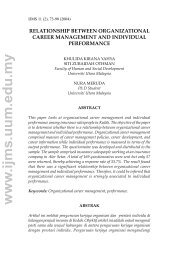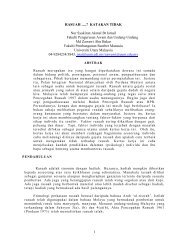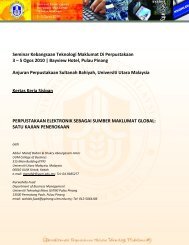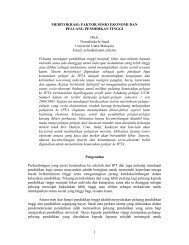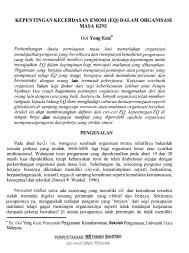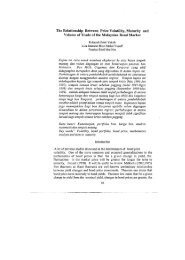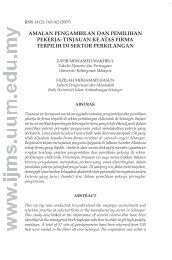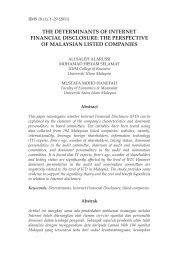The Development of ASEAN from Historical Approach
The Development of ASEAN from Historical Approach
The Development of ASEAN from Historical Approach
Create successful ePaper yourself
Turn your PDF publications into a flip-book with our unique Google optimized e-Paper software.
www.ccsenet.org/ass Asian Social Science Vol. 7, No. 7; July 2011<br />
Insert Map 2 Here<br />
China participation stimulated the progress on FTA in penetrating the global market. China’s decision to join<br />
<strong>ASEAN</strong>+3, enabled the <strong>ASEAN</strong> regional organization to become a world economy group at a global level (Zia<br />
Mahmud, 2005:11-14). China partaking in <strong>ASEAN</strong>, is important asset economically, thereby strengthening<br />
<strong>ASEAN</strong> economy. Moreover, China made several <strong>ASEAN</strong> countries like Malaysia, Thailand, Philippines and<br />
Indonesia as their fixed trading partner. China’s progress resembling other developed countries like Japan and EU,<br />
will contribute a positive impact to SEA especially matter concerning economic development and technology<br />
transfer.<br />
Insert Graph 1 Here<br />
<strong>The</strong> appearance <strong>of</strong> Chinese as a superpower in Southeast Asia are visible through other positive angle. After the<br />
end <strong>of</strong> Cold War in 1991, it implies the end <strong>of</strong> power competition between two superpowers, the United States and<br />
Soviet Union, and the formation <strong>of</strong> a unipolar system in international arena. <strong>The</strong> fall <strong>of</strong> Soviet Union left a gap to<br />
China to emerge as a communist power and replace the power <strong>of</strong> Soviet Union. <strong>The</strong> collapse <strong>of</strong> the Soviets,<br />
became the example to China in reinforcing the economy through mean <strong>of</strong> politic and military. As such, since the<br />
1990s, China was seen to strengthen economic growth by trade relationship without taking into account<br />
differences <strong>of</strong> ideological <strong>of</strong> a country, therefore promoting relationship and economic cooperation with regional<br />
states. <strong>The</strong> emergence <strong>of</strong> China’s power in the Asia Pacific region ultimately created balance <strong>of</strong> power with the<br />
United States America which is known as the unipolar power since 1991. This balance <strong>of</strong> power extremely<br />
important to avoid the domination <strong>of</strong> United States on small and weak countries residing in SEA. <strong>The</strong> entry <strong>of</strong><br />
China in <strong>ASEAN</strong>+3 made China the countervailing power over SEA’s dependence on the economy and politics <strong>of</strong><br />
United States. Obliquely China’s involvement is a protector that safeguard security, in adition to strengthening the<br />
political stability and economy in Southeast Asia.<br />
8. Conclusion<br />
To ensure political condition <strong>of</strong> Southeast Asia, <strong>ASEAN</strong> has struggled to implement various efforts even though<br />
the implementation was little bit slowly. This show <strong>ASEAN</strong> spirit and sense <strong>of</strong> belongings as what been stated by<br />
former Malaysia Prime Minister Tun Dr. Mahathir Mohammad and it is the secret <strong>of</strong> <strong>ASEAN</strong> successful by<br />
holding on 5 Cs which are Consolidation, Consultation, Consensus, Caring and Cornerstone. Consultation is one<br />
way <strong>of</strong> decision making among <strong>ASEAN</strong> countries’ leader with frequent contact and negotiation to gain Consensus<br />
or collective agreement in every decision made. Caring is a concern feeling and each <strong>ASEAN</strong> country need to has<br />
high spirit and always think about <strong>ASEAN</strong> interest besides their individual needs. Cornerstone is the direction that<br />
is needs every <strong>ASEAN</strong> country to establish their foreign policy as an <strong>ASEAN</strong> country based on <strong>ASEAN</strong> spirit.<br />
Consolidation or unity required all <strong>ASEAN</strong> countries to unite in any action taken. <strong>ASEAN</strong> was born while the<br />
world is having tension in Cold War and unsecured security. Because <strong>of</strong> this, it has made <strong>ASEAN</strong> busy in political<br />
problems. Even though <strong>ASEAN</strong> countries possess different strategic and security perspective, <strong>ASEAN</strong> unity has<br />
manage to come with big success in creating peace. It can be seen when ZOPFAN concept was declared during<br />
<strong>ASEAN</strong> Head <strong>of</strong> State Summit in Kuala Lumpur in 1971. <strong>The</strong> treaty based on sovereignty respect principles <strong>of</strong><br />
other countries, non-intervention on internal affairs, to solve regional internal issues with peace and effective<br />
cooperation. <strong>The</strong> treaty also had come out with code <strong>of</strong> conduct <strong>of</strong> peaceful solution for every conflict based on<br />
<strong>ASEAN</strong> principles as conflict solving mechanism. Until now, ZOPFAN concept manage to be the only applied<br />
regional diplomatic tool in providing mechanism and process for peaceful solution in any dispute. <strong>ASEAN</strong> was not<br />
the organization or body to establish cooperation among Southeast Asia countries but has become an important<br />
society to East Asia countries. Moreover, <strong>ASEAN</strong> and East Asia are also defending their interest and direction and<br />
working together to increase regional economic integration. In order to measure the effectiveness <strong>of</strong> economic<br />
development, <strong>ASEAN</strong> needs several solid strategies to ensure member countries to enhance their economic level<br />
accordance to <strong>ASEAN</strong> direction to prosperous regional economy. By making China and Japan that have rapid<br />
growth in economy, it is an advantage for <strong>ASEAN</strong> to develop cooperation and maintaining peace among member<br />
countries. With constructive experiences and principles accepted by regional countries, <strong>ASEAN</strong> become stronger<br />
in establishing stability and prosperous according to their own mould.<br />
References<br />
Abdul Razak & Abdullah Baginda. (1990). National security issues in Malaysian foreign policy. In Mohamad<br />
Azhari Karim, Lewellyn D. Howell and Grace Okuda (Eds.), Malaysian foreign policy, issues and perspective.<br />
Kuala Lumpur: Institut Tadbiran Awam Negara.<br />
Allan Gyngell. (1983). Looking outwards: Asean’s external relations. In Alison Broinowski (Ed.). Understanding<br />
Asean. London: Macmillan Press Ltd.<br />
182<br />
ISSN 1911-2017 E-ISSN 1911-2025




